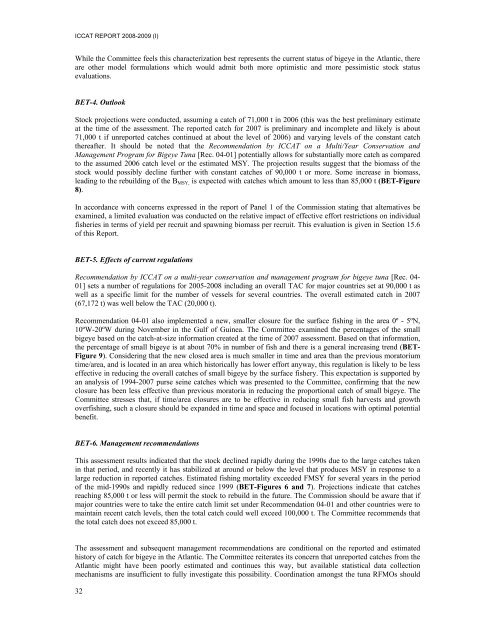REPORT OF THE STANDING COMMITTEE ON RESEARCH ... - Iccat
REPORT OF THE STANDING COMMITTEE ON RESEARCH ... - Iccat
REPORT OF THE STANDING COMMITTEE ON RESEARCH ... - Iccat
You also want an ePaper? Increase the reach of your titles
YUMPU automatically turns print PDFs into web optimized ePapers that Google loves.
ICCAT <strong>REPORT</strong> 2008-2009 (I)While the Committee feels this characterization best represents the current status of bigeye in the Atlantic, thereare other model formulations which would admit both more optimistic and more pessimistic stock statusevaluations.BET-4. OutlookStock projections were conducted, assuming a catch of 71,000 t in 2006 (this was the best preliminary estimateat the time of the assessment. The reported catch for 2007 is preliminary and incomplete and likely is about71,000 t if unreported catches continued at about the level of 2006) and varying levels of the constant catchthereafter. It should be noted that the Recommendation by ICCAT on a Multi/Year Conservation andManagement Program for Bigeye Tuna [Rec. 04-01] potentially allows for substantially more catch as comparedto the assumed 2006 catch level or the estimated MSY. The projection results suggest that the biomass of thestock would possibly decline further with constant catches of 90,000 t or more. Some increase in biomass,leading to the rebuilding of the B MSY, is expected with catches which amount to less than 85,000 t (BET-Figure8).In accordance with concerns expressed in the report of Panel 1 of the Commission stating that alternatives beexamined, a limited evaluation was conducted on the relative impact of effective effort restrictions on individualfisheries in terms of yield per recruit and spawning biomass per recruit. This evaluation is given in Section 15.6of this Report.BET-5. Effects of current regulationsRecommendation by ICCAT on a multi-year conservation and management program for bigeye tuna [Rec. 04-01] sets a number of regulations for 2005-2008 including an overall TAC for major countries set at 90,000 t aswell as a specific limit for the number of vessels for several countries. The overall estimated catch in 2007(67,172 t) was well below the TAC (20,000 t).Recommendation 04-01 also implemented a new, smaller closure for the surface fishing in the area 0º - 5ºN,10ºW-20ºW during November in the Gulf of Guinea. The Committee examined the percentages of the smallbigeye based on the catch-at-size information created at the time of 2007 assessment. Based on that information,the percentage of small bigeye is at about 70% in number of fish and there is a general increasing trend (BET-Figure 9). Considering that the new closed area is much smaller in time and area than the previous moratoriumtime/area, and is located in an area which historically has lower effort anyway, this regulation is likely to be lesseffective in reducing the overall catches of small bigeye by the surface fishery. This expectation is supported byan analysis of 1994-2007 purse seine catches which was presented to the Committee, confirming that the newclosure has been less effective than previous moratoria in reducing the proportional catch of small bigeye. TheCommittee stresses that, if time/area closures are to be effective in reducing small fish harvests and growthoverfishing, such a closure should be expanded in time and space and focused in locations with optimal potentialbenefit.BET-6. Management recommendationsThis assessment results indicated that the stock declined rapidly during the 1990s due to the large catches takenin that period, and recently it has stabilized at around or below the level that produces MSY in response to alarge reduction in reported catches. Estimated fishing mortality exceeded FMSY for several years in the periodof the mid-1990s and rapidly reduced since 1999 (BET-Figures 6 and 7). Projections indicate that catchesreaching 85,000 t or less will permit the stock to rebuild in the future. The Commission should be aware that ifmajor countries were to take the entire catch limit set under Recommendation 04-01 and other countries were tomaintain recent catch levels, then the total catch could well exceed 100,000 t. The Committee recommends thatthe total catch does not exceed 85,000 t.The assessment and subsequent management recommendations are conditional on the reported and estimatedhistory of catch for bigeye in the Atlantic. The Committee reiterates its concern that unreported catches from theAtlantic might have been poorly estimated and continues this way, but available statistical data collectionmechanisms are insufficient to fully investigate this possibility. Coordination amongst the tuna RFMOs should32
















